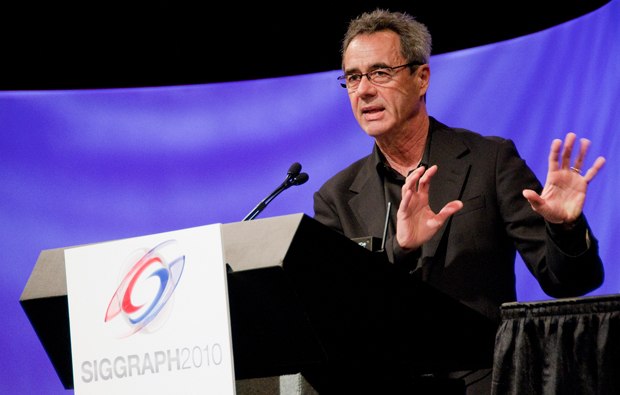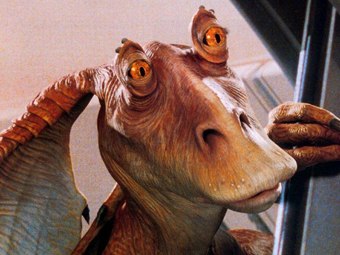Jim Morris, General Manager and Executive Vice President of Production at Pixar Animation Studios has over 23 years experience as a producer and production executive in the motion picture industry. He came to the 37th Annual SIGGRAPH, his 20th time in attendance, with a message.
Jim posed the rhetorical question, “Who comes to SIGGRAPH?” It is the people who, at some point early in life, watched a movie that lit a spark in them. For Jim, it was stop animation in some of the older movies like Jason and the Argonauts.
written by Eric Post
Jim Morris, General Manager and Executive Vice President of Production at Pixar Animation Studios has over 23 years experience as a producer and production executive in the motion picture industry. He came to the 37th Annual SIGGRAPH, his 20th time in attendance, with a message.
Jim posed the rhetorical question, “Who comes to SIGGRAPH?” It is the people who, at some point early in life, watched a movie that lit a spark in them. For Jim, it was stop animation in some of the older movies like Jason and the Argonauts.
Jim worked his way up from jobs like cutting movies at a local TV station, to commercials, to managing and then on to effects producer. This was in the height of the photochemical era. Digital movie making had begun though most of the industry had not recognized the signs.
George Lucas was one of those who did recognize the new tools and married some of the digital techniques with the traditional industry. Lucas mounted cameras on movable platforms and used blue screen rotoscoping for some of the scenes in Star Wars. At the center of what Lucas was doing was the computer and Lucas was one of the pioneers that turned to this new tool for his movie making.
There is a history to be told about the growth of computer graphics in the movie industry and Jim told it with enthusiasm.
Steven Spielberg’s Always with Richard Dreyfuss was a remake of a 1943 movie, “A Guy Named Joe,” about a fighter pilot who died and came back to help his buddies. In “Always,” Dreyfuss played the part of a firefighter who returned from the dead to help his friends. Jim worked on that movie and said that one of the more notable special effects scenes was the A-26 bomber flying through the flames to save the firefighters. Some of the filming involved Christmas trees on fire and model airplanes being filmed from the vantage point of an ultra-light aircraft flown behind them. Some of the planes were simply hung from a gantry in a steel building. The movie used over 10,000 Christmas trees and when Jim sent the clips to Spielberg, he was surprised that Steven called and rejected it. Jim did some cutting and went to Steven and showed the film strip in a longer version. That made the difference. How the sequences are placed together makes a substantial difference in the final product. Digital cutting today is much easier with modern tools.
Pixar was sold off from Lucas Films at about the same time and Jim stayed and continued to work with Lucas Digital, Ltd., Industrial Light & Magic, Lucasfilm Animation and Skywalker Sound. He had a small crew and they were dedicated to digital tools.
The Abyss was another milestone movie from the late 80's. The pseudopod (the water creature that came to observe the crew on the ocean floor) was the first time a digital character had been afforded any substantial screen time, about 90 seconds. Jim looked at hydraulics, etc, but to make it as cool as it was intended to be, it would have to be digital. The challenge for this film was compositing the CG and the live action and making the creature fit in with the real world. Facial scanning was rather primitive at the time so making the pseudopod adopt the shape of one of the crew members face was also a challenge. Some of the shots were processed on one of the Cray super computers at Cray, Inc.
Terminator 2 was the first time that a human actor was integrated with a CG character and the movie was dependent on a CG bad guy. Motion capture did not exist. The best way to integrate the movements was to film the actor in his underwear with grid lines painted on his body when he ran. Even the quirks of a sports injury were captured by film and then used to prepare the digital model for movement. One notable scene was where the digital Terminator walked out of a fire and seemingly morphed back into the actor in the police uniform. The splicing had to be perfect to be believable and the movements had to match.
Jurassic Park was another milestone in CG movie making. Spielberg had a big vision in mind. Animatronics was not going to work for the moving herds of dinosaurs. Stop action was considered early in the making of the movie to solve some of the problems but it became clear that this was not going to take the movie to the level it needed to go. Stop action, and the experience of the stop action team, was then used to set up the movements for the CG animators. This turned into a pivotal work for the CG where lifelike motion in dinosaurs helped the audience believe they were really there. Jim recalled the scene where the Raptor chased the boy into the freezer and the door slammed on the dinosaur’s head. When Jim learned that there was no live model used, that the door was integrated entirely with the CG animal, he knew this was another pivotal work. Hollywood had its wake-up call and Jim knew CG was here to stay.
Forrest Gump was the pregenitor to invisible effects. Much of the CG in that movie simply was for supporting roles. The digital birds leaving a field, symbolic of the loss of innocence, demonstrated how the subtle effect of CG could still be powerful and moving. Another new effect was the meeting between Gump and President Kennedy where even deceased people can move and say things that never really took place. The scene where Lt. Dan was in the wheelchair without his legs was another demonstration of how CG could alter the appearance of an actor, even in very emotional scenes.
Jim spoke of some of the short movies made in the mid 80's that were entirely CG with a story line. Of course, one of the landmark movies was Toy Story where Pixar blended form and content.
In 1999, the Mummy was made using motion capture. Scenes where the mummy moved quickly and needed the nuances of what a live actor would do in an action scene were excellent for MoCap.
Good or bad, everyone remembers Jar Jar Binks, another example of how some of the faster action scenes benefitted from MoCap.
Jim spoke a lot of the digital characters like Davy Jones in the Pirates of the Caribbean series and Gollum of Lord of the Rings because, like actors, they were the center seat to the movie. As time went on, Lucas moved away from actors and towards all digital. By the time of Star Wars, Episode 3, instead of mostly actor movies with some CG in them, Lucas had moved to mostly CG with just a bit of acting.
Jim went to Pixar at about the same time as the Pirates in the Caribbean movies were made. He started with Wall-E which was a movie that Jim felt he had worked and trained for all his life. The idea of everyone leaving Earth and forgetting to shut off the last robot was perfect for CG.
Jim spoke briefly about John Carter of Mars, due out in 2012. John Carter is a character of Edgar Rice Burroughs that was serialized in February through July of 1912. There were 5 prior attempts at making a movie about the books. One involved Tom Cruz. Jim said that this kind of movie needed CG and the tools just were not there before to make it.
Nobody sets out to make a bad film, they just happen. Some of the more quirky films, though, were the most fun to work on. Silent films are great. Sound gives movie makers one more tool to use. Black and White was also great. Adding color brought more expression. Today, digital has brought much to the screen. In the last 25 years we have seen what great artists have done with these tools.
This is just a start to take cinema to the next level. For the hands of those who create the tools, Jim says, “keep it going.” Make the next movie that sparks a kid to carry forward and be a part of this in the future.
Dan Sarto is Publisher and Editor-in-Chief of Animation World Network.










